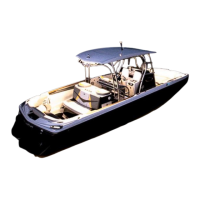First Time Operation
Whentakingtothewaterforthersttime,youmustkeepinmindafewgeneral
guidelines:
• Practice makes perfect! Start in calm water with no wind or current and plenty of
room until you get the feel for the boat and its controls.
• Proceed slowly! Give yourself time to think, react and maneuver.
• Recognize outside forces! Check the wind direction and velocity, as well as water
currents and waves.
• Have a crew on hand! Have friends or family ready with fenders, lines and a boat
hook to assist you when docking, as well as launching and loading.
• Remember that a boat is not an automobile! Boats cannot be maneuvered and
stopped like a car. Boats steer from the stern (rear) and have no brakes.
Basic Maneuvering
Steering response is dependent upon three (3) factors: rudder position, motion and
throttle. While high-speed maneuvering is relatively easy and takes little practice, slow-
speedmaneuveringisfarmoredicultandrequirestimeandpracticetomaster.
With both steering and propulsion at the rear of the boat, the initiation of a turn pushes
the stern of the boat away from the direction of the turn. The stern follows a larger turn-
ing circle than the bow. This is especially important to remember when making maneu-
vers within close quarters.
While theeects ofunequalpropeller thrust(torque steering),wind,and current
may not always be present, a practiced driver will use them to his/her advantage.
Unequal thrust is a phenomenon shared by all single-engine, propeller-driven boats.
With the rudder in the straight-ahead position, a counterclockwise rotation propeller
tends to cause the boat to drive to port when going forward, and to starboard when go-
ing backward.
Athighspeed,thereiscompensationforthiseect,anditisvirtuallynon-existent.
But,atslowspeed—andespeciallyduringbacking—theeectcanbeverypronounced.
This is the main reason that most experienced drivers approach with the dock to the
starboard of the boat.
Stopping—or checking headway—is a technique that must be mastered. With no
brakes, reverse must be used to stop the boat. The momentum of the boat will vary ac-
cording to the load. Make it a practice to slow to no-wake speed before shifting into
reverse.
When practicing maneuvering techniques, always do so in open water that is free
oftrac.Adequate practicemaymakethedierencebetweenapleasurable boating
experience or a potentially damaging (at the very least, embarrassing) one.
High Speed Operation
MasterCraft boats are designed to be a high-perfor-
mance boat. Professional drivers with advanced operat-
ing skills perform high-speed maneuvers and turns on-
a-dime. DO NOT attempt to duplicate or simulate these
feats. Paid, professional drivers log thousands of hours
on the water and carefully choreograph every move.
Plans are made in advance in the event the routine must
be aborted. Maneuvers of this nature could cause serious
injury or death, as well as damage to your MasterCraft
boat that will not be covered under warranty.
Boat operators should never attempt to dupli-
cate operational skills of professional drivers.
When such maneuvers fail, it can result in se-
rious injury or death.
For the best engine performance and longevity, the
wide-open-throttle (WOT) engine operation must be
nearthetopof,butwithin,thespeciedWOToperating
range. To adjust the WOT operating range, select a pro-
peller with the proper diameter and pitch. The propel-
ler supplied on the boat was chosen for best all-around
performance under average operating conditions.
Load,weather,altitudeandboatconditionallaect
WOT engine operation. If the boat is used for several dif-
ferent applications such as wakeboarding, barefooting
and cruising, it may be necessary to have two (2) or more
propellersofdieringsizeandpitchtoallowtheengineto
operate in the WOT range for each application.
Propping the boat should be done after the boat
is loaded in the manner in which it would normally be
loaded for each application. For example, in propping
theboatforwakeboarding,lltheballasttanksandadd
the people and gear that normally would be expected
in the boat. Take the boat out and after warm-up, run
it at wide-open-throttle and note the maximum RPM.
EFI engines are equipped with RPM limiters to prevent
over-revving. Take note if the RPM limiter is activated.
If the WOT RPM is higher than the maximum RPM
in your engine’s WOT operating range, the boat is un-
der-propped. Installing a higher-pitched propeller will
reduce the WOT RPMs. An engine that is over-revving
may quickly experience catastrophic damage, which
will not be covered under warranty.
If the WOT RPM is lower than the minimum RPM
in your engine’s WOT operating range, the boat is over-
propped. Installing a lower-pitched propeller will in-
crease WOT RPMs.
An engine that is under-revving is “lugging.” This
places a tremendous load on the pistons, crankshaft
and bearings and can cause detonation, piston seizure
and other engine damage, which will not be covered
under warranty.
MasterCraft 2012 Owners Manual • Preparation • Page 3-9

